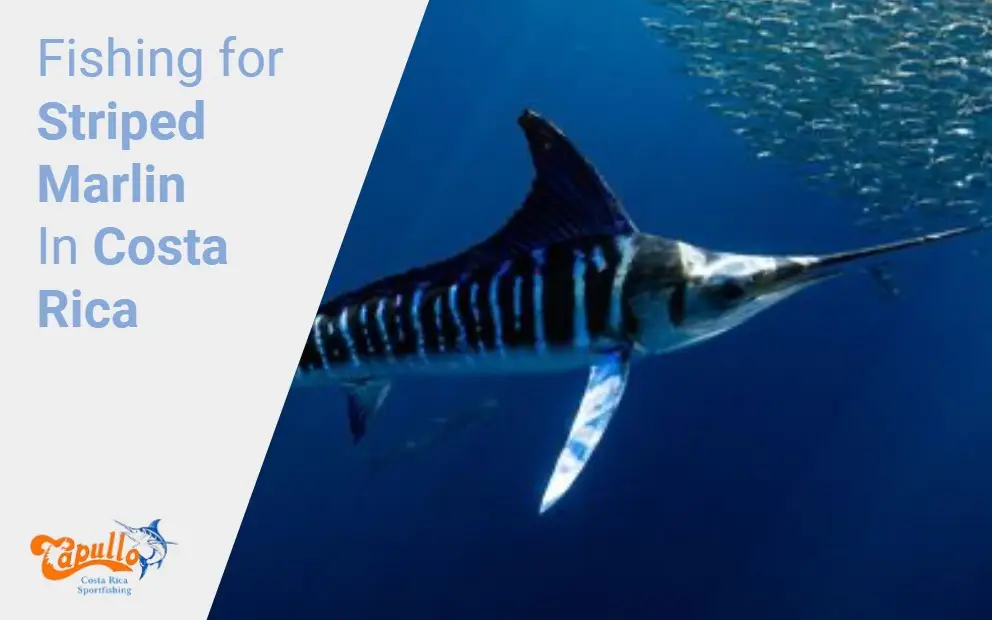
Striped Marlin Fish: Catching and Understanding Striped Marlin Fishing in Costa Rica 2023
Attention, avid sport fishermen and fishing enthusiasts! Suppose you’re seeking the ultimate adventure on the open waters, one that’s sure to get your heart racing. In that case, you don’t want to miss out on the exhilarating experience of catching a Striped Marlin in the abundant fishing grounds of Costa Rica, in the year 2023.
If you are looking to catch Striped Marlin in Costa Rica, but don’t want to worry about choosing the perfect location or getting the right equipment, book a charter trip with Capullo sportfishing charter, located in Guanacaste Province, Costa Rica.
For more information call: +1 506-8569-3516
From US or Canada you have to dial +11 506 8569 3516
Table of Contents
Why is Costa Rica is a great place to catch Striped Marlin?
With its rich biodiversity and favorable climate, Costa Rica has rightly earned its place as a world-renowned sportfishing destination. The country’s Pacific coast, in particular, offers an unmatched opportunity to encounter these iconic marine creatures. Here, you’ll find an abundance of Striped Marlin during their peak season, making it the ideal spot for a thrilling fishing expedition.
But it’s not just about the adrenaline rush — understanding the behavior and habitat of the Striped Marlin is key to improving your chances of reeling in the big one.
Stay tuned for our upcoming guide, where we will reveal the secrets to unlocking the full potential of your next fishing expedition in Costa Rica. Get ready to make waves and land that big catch in 2023!
Remember, the ocean awaits, and the Striped Marlin are calling out to you. Will you be ready?
Happy fishing, and tight lines!
PRO TIP: In Costa Rica, it is illegal to remove Striped Marlin from the water.
All billfish, including marlin and sailfish, are catch-and-release and protected by law.
What is a Striped Marlin?
The Striped Marlin , also known as “Marlin Rayado” in Spanish, is a magnificent fish species belonging to the Istiophoridae family. Renowned for its vibrant colors and impressive size, the Striped Marlin is a prized gamefish that attracts sport fishing enthusiasts from around the globe.
What does a Striped Marlin look like?
With its long, slender body and distinctive, high, pointed dorsal fin, the Striped Marlin is easily recognizable. These powerful creatures can reach lengths of up to 12 feet (3.6 meters) and weigh anywhere between 200-400 pounds (90-180 kilograms), making them an extraordinary catch for thrill-seeking anglers.
One of the most striking features of the Striped Marlin is its brilliant coloration. As the name suggests, the fish is adorned with vertical blue or lavender stripes that run along its body, which give it a stunning, sleek appearance. These bold stripes, combined with its shimmering silver belly, make the Striped Marlin a sight when it breaches the water’s surface.
The largest Striped Marlin ever caught was a 494-pound fish caught by Bill Boniface in Tutukaka, New Zealand on January 16, 1986. The fish was 115.67 inches long and had a 57-inch girth.
Where Can You Catch Striped Marlin?
The allure of Striped Marlin fishing extends far beyond the pristine fishing grounds of Costa Rica. These remarkable creatures can be found in numerous locations worldwide, spanning across the tropical and subtropical waters of the Atlantic, Indian, and Pacific Oceans.
In the Pacific Ocean, the Striped Marlin is abundant along the coastlines of Central and North America, particularly in regions such as Mexico, Guatemala, Panama, and, of course, Costa Rica. These areas offer favorable oceanic conditions, including upwellings and rich food sources that attract the Striped Marlin during their migrations.
Moving across the globe, the waters surrounding Hawaii, Fiji, and Australia’s Great Barrier Reef are also known to be home to healthy populations of Striped Marlin . These destinations offer ample opportunities for anglers to try their luck at hooking these magnificent fish, providing picturesque backdrops of stunning natural beauty.
In the Atlantic Ocean, the Striped Marlin can be found in regions such as the Caribbean, off the coast of Venezuela, and along the eastern shores of the United States, including Florida and the Gulf of Mexico. The warm waters and abundant prey attract these migratory fish during specific times of the year, luring anglers with the promise of an unforgettable fishing experience.
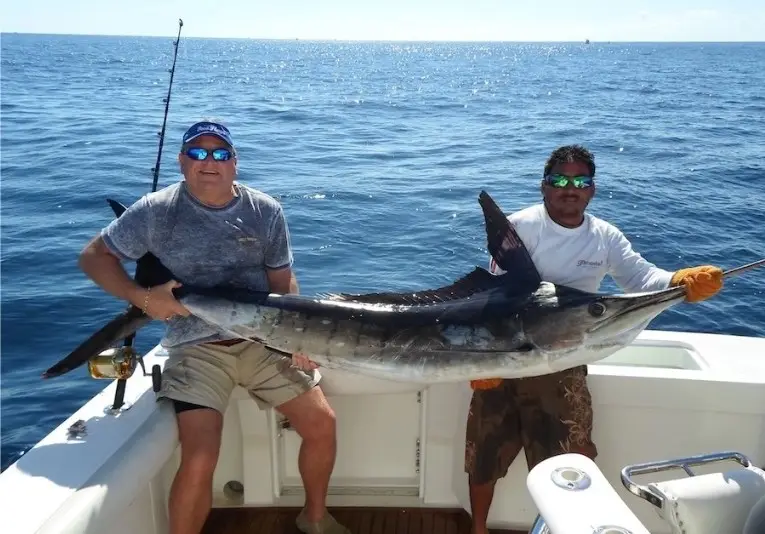
What are the Best Places to Catch Striped Marlin in Costa Rica?
Found primarily in the tropical and subtropical waters of the Pacific Ocean, the Striped Marlin thrives in the balmy currents off the coast of Costa Rica. From December to April, these majestic creatures are most abundant in the region, making it the peak fishing season for those looking to engage in an unforgettable battle of wills.
Below are some of the best places to catch Marlin in Costa Rica:
- Quepos/Manuel Antonio:
- Golfo Dulce:
- Playa Flamingo/Tamarindo:
Regarding the distance from shore, targeting Striped Marlin in Costa Rica often requires venturing a few miles offshore into deep-sea waters. The exact distance may vary depending on the season, prevailing currents, and baitfish movements. It’s advisable to consult with experienced local fishing charters and guides who possess extensive knowledge of the area, ensuring you reach the optimal fishing grounds for a memorable encounter with the Striped Marlin .
What is the Best Time to Catch Striped Marlin in Costa Rica?
When it comes to targeting the exhilarating Striped Marlin in the rich fishing grounds of Costa Rica, timing is crucial. Understanding the best time to fish for Striped Marlin can significantly increase your chances of encountering these majestic creatures and landing that trophy catch you’ve been dreaming of.
Season:
The prime season to catch Striped Marlin in Costa Rica spans from December to April. This period aligns with the drier season, providing optimal weather conditions for fishing. During this time, the ocean currents bring nutrient-rich waters closer to the shore, attracting the baitfish that the Striped Marlin eagerly pursue. As the abundance of prey increases, so do your chances of successful encounters with these powerful gamefish.
Time of Year:
Within the prime season, there are certain months that stand out as exceptionally fruitful for Striped Marlin fishing. January through March is often considered the peak time, when large concentrations of Striped Marlin can be found offshore. Anglers from around the world flock to the renowned fishing hotspots of Costa Rica during these months, seeking to test their skills against these acrobatic fighters.
Time of Day:
In terms of the best time of day to catch Striped Marlin , the early morning and late afternoon hours are usually the most productive. Striped Marlins are known to be more active near the surface during these times. Capitalize on the low-light conditions and the periods when feeding activity is heightened as the sun rises or sets over the horizon.
Weather Conditions:
Weather conditions play a significant role in Striped Marlin fishing success. Generally, calm seas and stable weather patterns are preferable, as they provide favorable conditions for fish to feed near the surface. Clear skies and moderate winds are ideal, allowing you to navigate the waters with ease and spot any telltale signs of feeding activity, such as birds diving or baitfish breaking the surface.
Do You Need a Boat to Catch Striped Marlin in Costa Rica?
If you are planning to catch Striped Marlin in Costa Rica, access to a boat is essential. Booking a fishing charter with a reputable company like Capullo Fishing Charters ensures you have the necessary tools, guidance, and local knowledge to increase your chances of encountering these powerful gamefish. While kayak marlin fishing may be an option for extreme enthusiasts with extensive experience and proper safety measures, it is not typically recommended for most anglers due to the challenges and risks involved.
How to Catch a Striped Marlin: A Guide to Successful Angling
If you’re eager to hook into the thrilling and powerful Striped Marlin, it’s important to equip yourself with the right techniques and tactics. By understanding the various methods used to target these majestic gamefish, you can increase your chances of a successful encounter and an exhilarating battle. Here are some popular techniques employed by anglers to catch Striped Marlin :
- Fly Fishing:
For the adventurous angler seeking a challenge, fly fishing for Striped Marlin can be an incredibly rewarding experience. Using large, brightly colored flies that imitate baitfish, you can entice these predators to strike. Working with a skilled fly fishing guide will provide you with valuable insights into casting techniques, fly selection, and how to play and land the marlin once hooked.
- Jigging:
Jigging involves dropping heavy metal jigs vertically into the water column to attract Striped Marlin . This technique mimics the movement of injured or distressed baitfish, enticing the marlins’ predatory instincts. Using a specialized jigging rod and reel combo, you can jig up and down while maintaining tension on the line, enticing a strike from these powerful gamefish.
- Fishing with Live Bait:
Presenting live bait is a widely used and highly effective technique for targeting Striped Marlin . Anchoring or drifting near known marlin hotspots, you can deploy live baitfish such as mackerel, bonito, or mullet. Rigging them with circle hooks and allowing them to swim naturally will increase the chances of enticing a marlin to strike.
- Trolling:
Trolling or offshore trolling, is a traditional method employed by many anglers to target Striped Marlin. By trolling a spread of artificial lures at various depths and distances behind the boat, you can cover a larger area and increase your chances of encountering marlins. Specialized trolling rods and reels, equipped with outriggers and downriggers, are used to present the lures effectively.
What Gear Do You Need to Catch Striped Marlin?
To tackle the powerful and elusive Striped Marlin , having the right gear is crucial. Equipping yourself with the appropriate rods, reels, lines, and other tackle ensures that you have the necessary equipment to handle these magnificent gamefish. Here’s a breakdown of the gear you’ll need for a successful Striped Marlin fishing expedition:
- Rods and Reels:
For targeting Striped Marlin , you’ll need a sturdy, lightweight, and responsive rod capable of handling the intense fight. Look for a heavy-duty offshore trolling rod, typically made of fiberglass or graphite composite, designed to withstand the strain of a marlin battle. Paired with a high-quality big game reel, such as a lever drag reel with a large line capacity, you’ll have the power and control needed to handle these mighty fish.
The cost of a suitable rod and reel combo can vary depending on the brand and quality. High-quality setups can range from $500 to $1,500 or more. However, keep in mind that purchasing all the equipment for a one-time fishing trip can be a significant investment.
- Fishing Line:
Opt for a high-quality, abrasion-resistant monofilament or braided line, typically ranging from 30 to 80-pound test.
The cost of fishing line varies depending on the brand, material, and pound test, ranging from $20 to $100 per spool.
- Tackle and Hooks:
A well-stocked tackle box is essential for Striped Marlin fishing. You’ll need a variety of trolling lures, artificial baits, and live bait rigs to entice the marlins’ predatory instincts. Circle hooks, with sizes ranging from 7/0 to 10/0, are commonly used for catch-and-release practices, minimizing the risk of gut-hooking the fish.
The cost of tackle and hooks can vary depending on your preferences and the brands you choose. On average, anglers can spend around $100 to $300 on a selection of trolling lures and hooks.
- Fighting Chair and Harness:
When battling a Striped Marlin, having a fighting chair and harness can make a significant difference. The fighting chair provides stability, comfort, and leverage for anglers during the fight, while the harness helps distribute the fish’s weight, decreasing strain on the angler’s body.
The cost of a professional-grade fighting chair and harness can range from $1,000 to $5,000 or more, depending on the brand and features.
While purchasing all this gear individually can add up, booking a fishing charter can potentially save you money. Charter services like Capullo Fishing Charters provide all the necessary equipment, including rods, reels, lines, bait, tackle, and even fighting chairs and harnesses. By opting for a charter, you avoid the upfront costs associated with buying expensive gear, making it a more cost-effective choice.
What Bait to Use to Catch Striped Marlin
Selecting the right bait plays a crucial role in enticing Striped Marlin to bite. Whether you opt for live bait or artificial alternatives, understanding what appeals to these magnificent gamefish can significantly increase your chances of a successful catch. Here’s a closer look at the types of bait commonly used to target Striped Marlin and how to effectively bait your hook:
- Live Bait:
Using live bait can be highly effective for Striped Marlin . Common live baitfish such as mackerel, bonito, mullet, or even skipjack tuna are excellent choices. Striped Marlin are opportunistic predators, and the natural swimming action and scent of live bait can trigger their feeding instincts.
To bait your hook with live bait, follow these steps:
- Rigging: Start by attaching a circle hook to a short leader, ensuring the hook size matches the baitfish’s size.
- Hook Placement: Insert the hook through the baitfish’s nose, which allows it to swim naturally and remain lively.
- Bait Presentation: Drop the baitfish into the water near the marlin hotspot and allow it to swim freely. Monitor its movement and adjust the depth or distance from your boat to entice a strike.
- Artificial Bait:
If live bait is not readily available, or if you prefer a different approach, using artificial lures can be an effective alternative. Striped Marlin are known to strike at a variety of artificial baits that mimic baitfish or prey. These can include trolling lures, such as skirted lures, diving plugs, or soft plastic swimbaits.
To bait your hook with artificial lures, follow these steps:
- Lure Selection: Choose a lure that imitates the natural swimming action and appearance of baitfish. Opt for bright colors such as blue, green, or pink, which can attract the attention of Striped Marlin .
- Rigging: Attach the lure to your line using the appropriate knot or snap swivel, ensuring it is securely fastened.
- Lure Presentation: Trolling the lure behind your boat at various speeds and depths can mimic the movement of live baitfish. Experiment with different patterns, speeds, and lure placements until you find what attracts the marlin’s attention.
it’s essential to keep your bait or lure in motion to imitate natural prey. Striped Marlin are attracted to movement, so vary your retrieves or troll patterns to increase your chances of enticing a strike.
Capullo boats in Tamarindo.
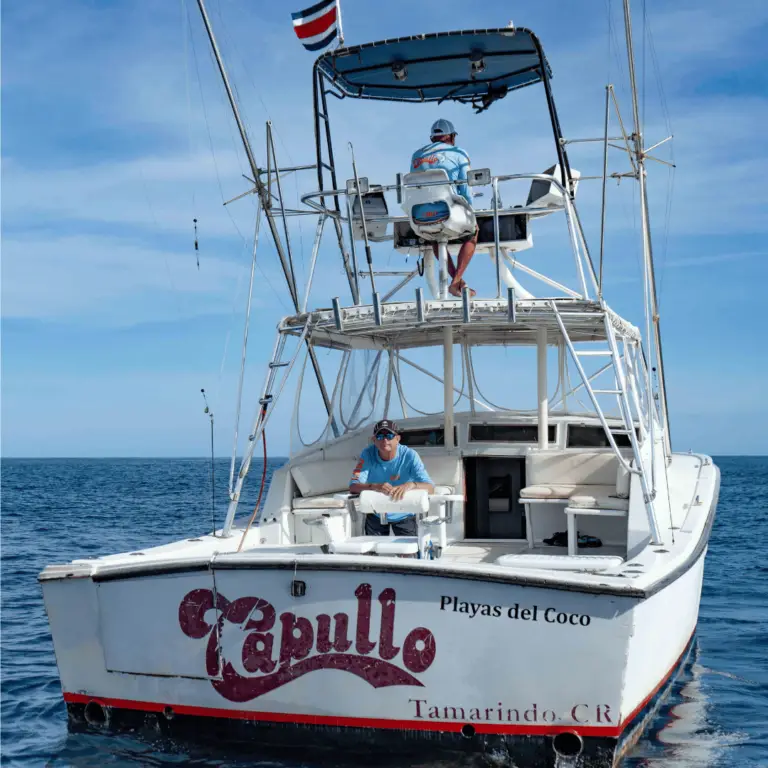
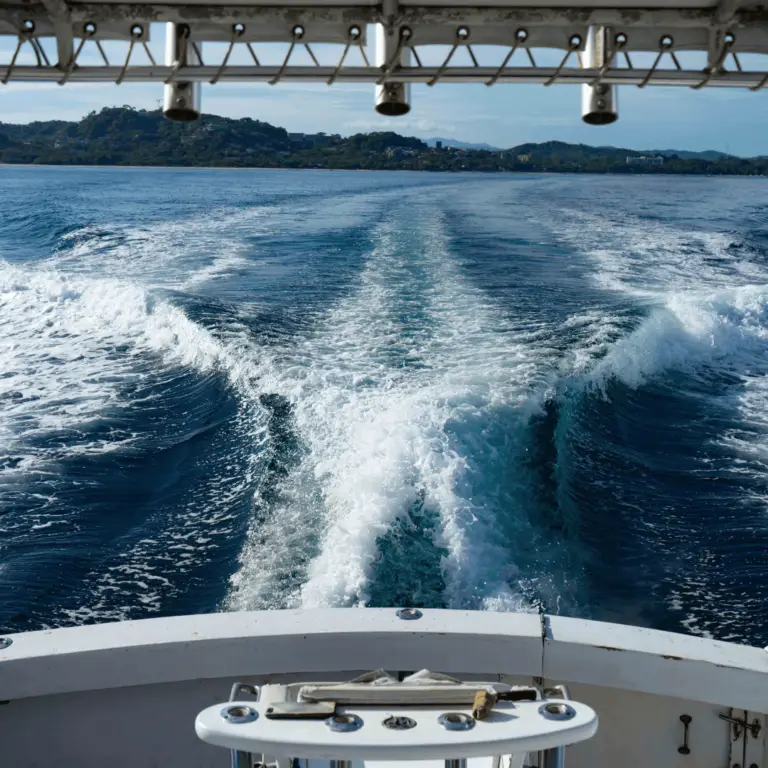
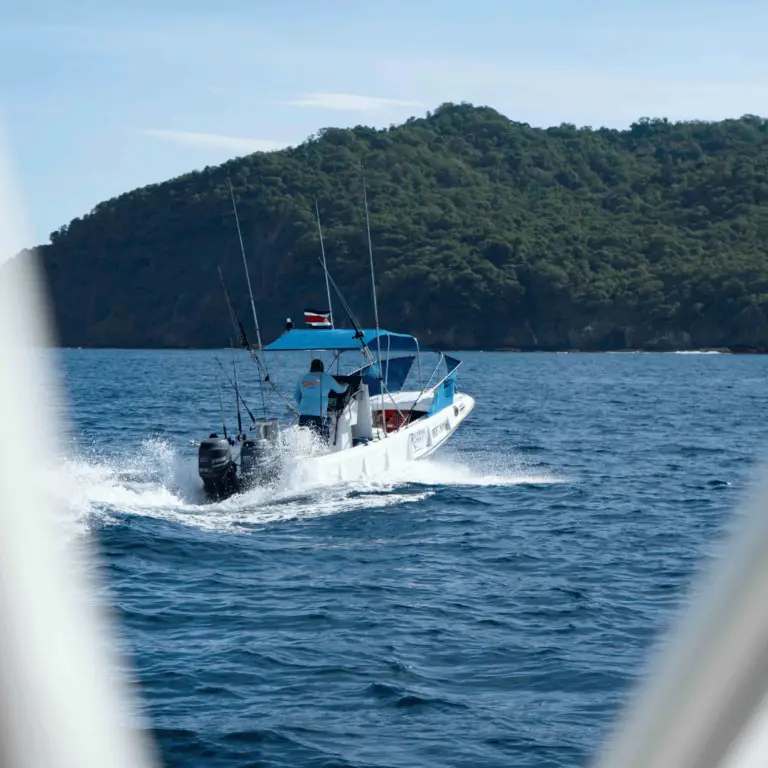


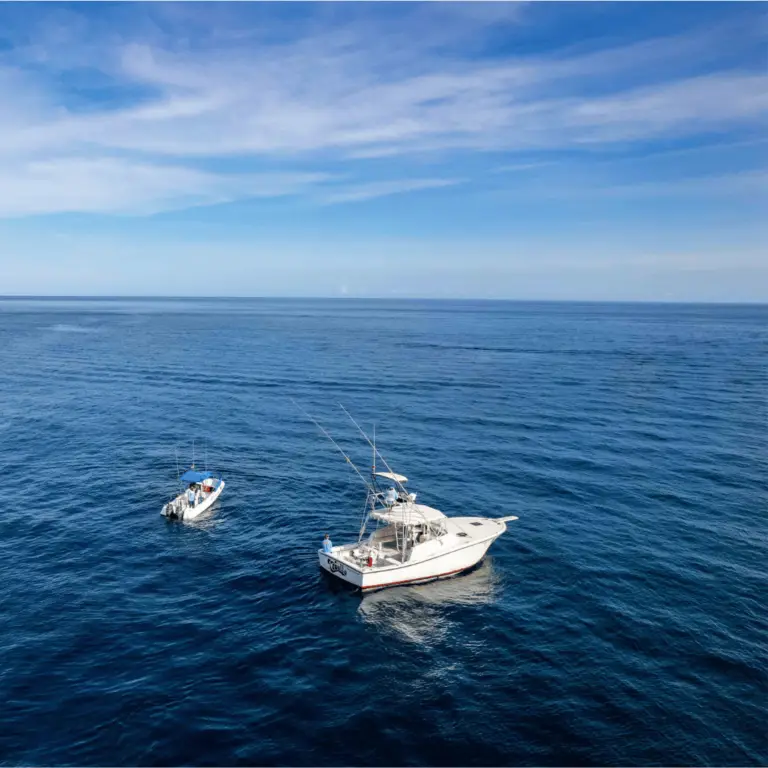
Reeling in Your Catch: Do Striped Marlin Have a Strong Pull?
Yes, Striped Marlin have a strong pull when you hook them. Their sheer size, speed, and strength make them formidable opponents in the water. Once hooked, these marlins often take off in powerful runs, stripping line from your reel and testing your tackle and skill as an angler.
It is not uncommon for Striped Marlin to make impressive leaps out of the water, known as tail walks, as they fight against the angler’s pull. These acrobatic displays, combined with their powerful runs, make for an exhilarating and challenging battle.
How to Release Striped Marlin Fish Back into Water Safely
Here are some guidelines on how to release Striped Marlin fish back into the water safely:
- Minimize Fight Time:
- Handle with Care:
- Reviving the Fish:
- Safe Release:
The Thrill of Striped Marlin Fishing with Capullo Fishing Charter
For anglers seeking the ultimate thrill and adventure, few experiences can compare to the adrenaline-pumping action of Striped Marlin fishing. These magnificent creatures have captivated fishermen’s hearts worldwide with their powerful pulls, acrobatic leaps, and captivating beauty. If you’re looking for the best solution to embark on an unforgettable Striped Marlin fishing excursion, look no further than Capullo Fishing Charter.
Capullo Fishing Charter is renowned for providing exceptional fishing experiences in Costa Rica’s abundant waters. Whether a seasoned angler or a novice looking to catch your first marlin, Capullo Fishing Charter offers the expertise, professionalism, and passion necessary for an exceptional fishing adventure.
FAQ
How fast does a Striped Marlin swim?
As one of the fastest fish in the ocean, the Striped Marlin can swim up to 50 miles per hour.
How long do Striped Marlin live?
Striped Marlins typically live for about ten years and reach full maturity within 2-3 years after birth. Male Striped Marlins reach maturity a bit more quickly than females do.
Where do Striped Marlin breed?
As for their breeding grounds, Striped Marlins undertake long migrations to reproduce. They often spawn in warm waters near the equator, with most breeding occurring in the Pacific Ocean. The exact locations of these breeding grounds are still the subject of ongoing research, but their migrations signify the importance of conserving these majestic creatures and their spawning grounds for future generations.
Do Striped Marlin sleep?
Striped Marlin do not appear to sleep at all, as they must constantly swim to pump water over their gills and obtain oxygen.
Is Striped Marlin edible?
Yes, Striped Marlin is edible. It is considered the best eating of all marlin species because of its tender flesh.
*Remember that in Costa Rica Striped Martin is strictly catch and release.
Are Striped Marlin endangered?
The Striped Marlin is not endangered or at risk of extinction. However, the IUCN has designated the Striped Marlin as “near threatened”.
How to tell the difference among Marlin species?
Differentiating between marlin species can be challenging, but several key features can help you distinguish between them. Here are some factors to consider when identifying different marlin species:
- Bill Shape and Size:
- Body Coloration and Markings:
- Size and Weight:
- Fin Shape and Position:
- Habitat and Geographic Distribution:
Are there Striped Marlin fishing tournaments in Costa Rica?
Yes, there are fishing tournaments in Costa Rica that include Striped Marlin.
- The 2022 Pelagic Rockstar Offshore Tournament was held at Marina Pez Vela in Quepos, Costa Rica. The tournament included billfish, yellowfin tuna, and dorado. Striped Marlin were worth 100 points per release.
- The 2022 Pelagic Pura Vida Blue Marlin Classic was held in Quepos, Costa Rica. This tournament celebrated the history of blue marlin fishing in Costa Rica. The tournament awarded 500 points per release for blue marlin, 250 points for black marlin, and 100 points for Striped Marlin.
